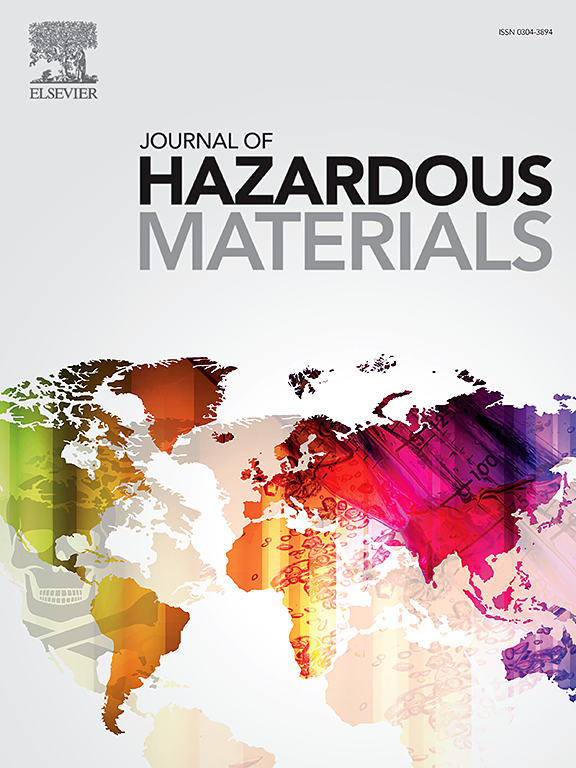从总浓度到生物可及负荷:通过概率暴露法和毒物动力学模型重新评估土壤重金属(样物质)的风险
IF 12.2
1区 环境科学与生态学
Q1 ENGINEERING, ENVIRONMENTAL
引用次数: 0
摘要
传统的健康风险评估(HRA)通常忽略了生物可及性,可能导致过高的风险估计。本研究系统研究了某工业集聚区126份土壤样品的重金属(类)s (HMs)特征,并在此基础上进行了生物可及性重金属(HMs)浓度的体外测定,并将其整合到概率HRA和内暴露水平预测中。概率HRA的研究结果表明,两种情况下的非致癌风险(无论有无生物可及性)均可忽略不计,但考虑生物可及性时,成人非致癌风险的概率可降低82.83%,儿童非致癌风险的概率可降低78.93%,同时致癌风险的高估可显著降低约70%。此外,基于生理的毒物动力学(PBTK)模型预测的内暴露水平表明,结合生物可及性可导致尿中HMs浓度大幅降低,Cd的下降幅度从60.41%到Cr的98.50%不等。此外,与验证值的偏差在所有金属和年龄组中都保持较低且更稳定。表明将生物可及性纳入风险评估可以更准确、更可靠地估计土壤有机质暴露,以避免高估相关健康风险,并支持在土壤环境健康管理中做出更明智的决策。本文章由计算机程序翻译,如有差异,请以英文原文为准。

From Total Concentration to Bioaccessible Load: Reassessing Soil Heavy Metal(loid)s Risks Through Probabilistic Exposure Approach and Toxicokinetic Modeling
Traditional health risk assessment (HRA) generally overlooks bioaccessibility, potentially leading to overestimated risk estimates. In this study, we systematically investigated the heavy metal(oid)s (HMs) characteristics of 126 soil samples collected from an industrial agglomeration area, based on which, in vitro assays were conducted to test bioaccessible HMs concentrations, and further integrated into both probabilistic HRA and the prediction of internal exposure levels. The study results of probabilistic HRA indicated that both scenarios showed negligible non-carcinogenic risks (with and without bioaccessibility), but the probabilities of non-carcinogenic risks could decrease by 82.83% for adults and 78.93% for children when considering bioaccessibility, along with a significant reduction on the overestimation of carcinogenic risks by approximately 70%. In addition, internal exposure levels predicted by a physiologically based toxicokinetic (PBTK) model demonstrated that incorporating bioaccessibility led to a substantial reduction in urinary HMs concentrations, with decreases ranging from 60.41% for Cd to 98.50% for Cr. Moreover, the deviations from the verification value were consistently lower and more stable across all metals and age groups, indicating that incorporating bioaccessibility into risk assessments provides a more accurate and reliable estimation of HMs exposure to avoid overestimation of associated health risks, and to support more informed decision-making in soil environmental health management.
求助全文
通过发布文献求助,成功后即可免费获取论文全文。
去求助
来源期刊

Journal of Hazardous Materials
工程技术-工程:环境
CiteScore
25.40
自引率
5.90%
发文量
3059
审稿时长
58 days
期刊介绍:
The Journal of Hazardous Materials serves as a global platform for promoting cutting-edge research in the field of Environmental Science and Engineering. Our publication features a wide range of articles, including full-length research papers, review articles, and perspectives, with the aim of enhancing our understanding of the dangers and risks associated with various materials concerning public health and the environment. It is important to note that the term "environmental contaminants" refers specifically to substances that pose hazardous effects through contamination, while excluding those that do not have such impacts on the environment or human health. Moreover, we emphasize the distinction between wastes and hazardous materials in order to provide further clarity on the scope of the journal. We have a keen interest in exploring specific compounds and microbial agents that have adverse effects on the environment.
 求助内容:
求助内容: 应助结果提醒方式:
应助结果提醒方式:


